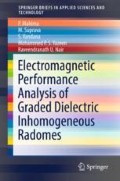Abstract
The design of airborne streamlined radomes is a daunting task as it has to encounter the constraints in fabrication and also provide sufficiently high performance (Burks in Antenna engineering handbook. McGraw-Hill, New York, 2007; Kozakoff in Analysis of radome enclosed antennas. Artech House, Norwood, 2010; Nair and Jha in IEEE Antennas Propag Mag 56(4):276–298, 2014) . Controllable artificial dielectric structures play a vital role in the design of such radome wall structures (Nair and Jha in Electron Lett 43(15):787–788, 2007; Nair and Jha in IEEE Trans Antennas Propag 57(11):3664–3668, 2009). The efficacy of variable thickness radome (VTR) to provide superior power transmission capability makes it a suitable candidate than constant thickness radomes (CTR) (Nair and Jha in IEEE Trans Antennas Propag 57(11):3664–3668, 2009; Nair et al. in CMC: Comput Mater Contin 40(2):131–143, 2014). Even with the advent of technology, fabrication of such streamlined airborne radomes with controllable dielectric parameters is an arduous job and may degrade the radome performance.
You have full access to this open access chapter, Download chapter PDF
Similar content being viewed by others
The design of airborne streamlined radomes is a daunting task as it has to encounter the constraints in fabrication and also provides sufficiently high performance (Burks 2007; Kozakoff 2010; Nair and Jha 2014) . Controllable artificial dielectric structures play a vital role in the design of such radome wall structures (Nair and Jha 2007; Nair and Jha 2009). The efficacy of variable thickness radome (VTR) to provide superior power transmission capability makes it a suitable candidate than constant thickness radomes (CTR) (Nair and Jha 2009; Nair et al. 2014). Even with the advent of technology, fabrication of such streamlined airborne radomes with controllable dielectric parameters is an arduous job and may degrade the radome performance. To circumvent this limitation in fabrication and to enhance the performance parameters of the radome, a novel radome wall structure based on inhomogeneous planar layer (IPL) has been reported in this book.
The effect of designing a tangent-ogive radome wall using an inhomogeneous planar layer to provide graded variation of dielectric parameters has been already demonstrated by the author (Nair et al. 2015). The antenna considered in this work was a planar slotted waveguide array antenna with cosine distribution. This study is further extended in the present work for other aperture distributions as well, and the performance of the radome with the inclusion of a radome paint so as to retain its superior EM characteristics even in hoarse environmental conditions has also been evaluated. Moreover, a hemispherical radome with this novel wall configuration for ground-based applications has been analyzed in this work. The performance of the radome enclosing slotted waveguide planar array antenna is compared with the conventional optimized radome designs such as constant thickness radome (CTR) and variable thickness radome (VTR) designs. Further the computed radiation characteristics of the graded dielectric inhomogeneous radome enclosed antenna system at preselected orientation of antenna in both the elevation and azimuth plane are analyzed that shows minimal degradations (in terms of beam width, SLL, and flash lobes ), which is desirable for radome applications.
Author information
Authors and Affiliations
Corresponding author
Rights and permissions
Copyright information
© 2018 The Author(s)
About this chapter
Cite this chapter
Mahima, P., Suprava, M., Vandana, S., Yazeen, M.P.S., Nair, R.U. (2018). Introduction. In: Electromagnetic Performance Analysis of Graded Dielectric Inhomogeneous Radomes. SpringerBriefs in Applied Sciences and Technology. Springer, Singapore. https://doi.org/10.1007/978-981-10-7832-3_1
Download citation
DOI: https://doi.org/10.1007/978-981-10-7832-3_1
Published:
Publisher Name: Springer, Singapore
Print ISBN: 978-981-10-7831-6
Online ISBN: 978-981-10-7832-3
eBook Packages: EngineeringEngineering (R0)




